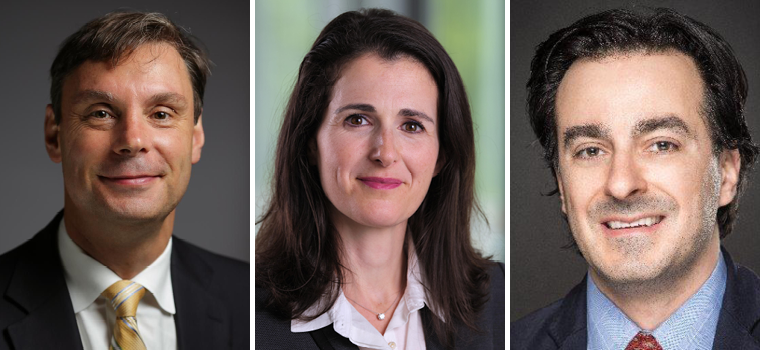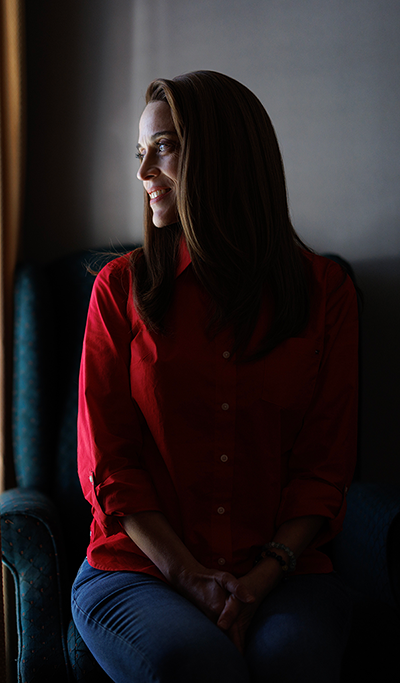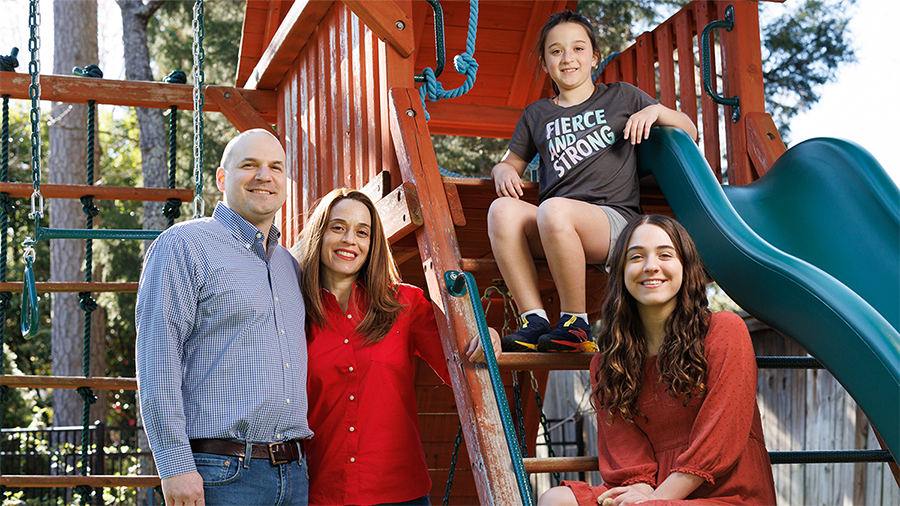
New Hope for Bladder and Other Urothelial Cancers
Talia Aron, MD, wasn’t alarmed at first when she started to feel some nasty lower back pain. Last September, the medical director at a telehealth company, had been traveling to professional conferences for days, sitting on airplanes and in hard-backed chairs.
But instead of getting better when she returned home to Greensboro, North Carolina, the pain got worse. “Looking back at a picture of me [at a conference] in Nashville, I was kind of a grey color,” Aron said.
By the time she saw her OB-GYN, the pain was so bad that her physician sent her straight to the emergency department in Greensboro.
Doctors at first thought that Aron had a kidney stone or infection. Then she was diagnosed with kidney cancer.
When she sought a second opinion at Duke Medical Center, she received what would turn out to be the correct diagnosis: a urothelial cancer that had already clawed its way into her kidney. Urothelial cancers include all cancers that grow out of cells that line the bladder and the ureters (tubes that drain urine from the kidneys to the bladder).
Historically, people with advanced urothelial cancer live, on average, for 16 months, with only 10% surviving five years or more on standard-of-care therapy.
But doctors at Duke Cancer Institute had a new treatment in mind for Aron that offered her much better odds. The only problem was the combination therapy, developed by a medical oncologist at Duke, was approved only for a select population of patients. She would need help from friends and physicians at Duke and beyond to get the best treatment for her.
Getting The Right Diagnosis
After Aron returned home, imaging showed a mass on her kidney, and it was growing rapidly. A urologist in Greensboro scheduled her for surgery to remove the kidney.
But just a few days before the scheduled surgery, James Wantuck, MD, one of her senior colleagues, encouraged her to seek a second opinion through 2nd MD, one of the health benefits offered by their employer, Accolade. That virtual consult — with David Braun, MD, PhD, a genitourinary medical oncologist at Yale School of Medicine — led her to Duke.
“Dr. Braun told me, ‘You are an hour away from Duke. You need to see the best,’” she said.
Braun reached out to Daniel George, MD, a genitourinary medical oncologist at Duke Cancer Institute and co-leader of the Center for Prostate and Urologic Cancers. Braun asked that George be on the lookout for Aron. Meanwhile, Aron arranged a meeting with Deborah Kaye, MD, a Duke urologic oncology surgeon, to get a biopsy of her tumor.
Even before seeing the biopsy results, Kaye suspected that Aron’s tumor might not be kidney cancer.

Kaye asked Aron the location of her pain. “When I pointed to my side, Dr. Kaye said that I should not be having pain there if this were kidney cancer. Then Kaye looked very carefully at my previous images and said that she thought I might have urothelial cancer. And she was the first one to have said that," said Aron.
While Aron was waiting in the clinic for her biopsy results, she started feeling worse. “I was getting rigors—shakes. I couldn’t get warm. I had a very high fever, which I now know is not uncommon with very aggressive cancers, but I didn’t know it then.”
The biopsy confirmed an upper-tract urothelial cancer that appeared like kidney cancer because it had already spread there.
“Nailing down the specific type of tumor that someone has is critical, because the drugs we use to treat urothelial cancers are completely different from kidney cancer drugs,” said George. “And it’s something we do well at Duke, where we have experts from medical and surgical specialties who work closely with cancer-specific pathologists and radiologists.”
The Tough Road to a New Therapy for a Tough Disease
The therapy that Aron would receive is a combination of pembrolizumab, an immunotherapy agent, and enfortumab vedotin, an antibody drug conjugate. Duke medical oncologist Christopher Hoimes, DO, had been studying this combination since 2017.

Hoimes’ reasons for believing that these two agents would work well together were complex, but he boiled down his thinking to this: targeting the cancer’s surface adhesion receptors, which is what enfortumab binds to, could potentially enhance the immune response.
But the odds were against Hoimes in a field where hundreds of cancer therapies and combinations had been tested and failed. Another matter threatening to hinder progress: the drugs he wanted to study were owned by two different companies.
“Companies are typically reluctant to combine their investigational products with an agent owned by another company because the new combination can limit their indications and increase side effects,” said George, who was not involved in the trials. “They must be convinced that a collaboration is worth the risk, extra time, and resources.”
Hoimes was motivated to push for a study of the combination because he was frustrated at watching patients suffer. For years he had seen patients get months of grueling chemotherapy and life-altering surgery that rewarded them with only a small increase in survival. And too many of his patients weren’t even eligible to get the chemotherapy due to other health issues, he said.
After Hoimes and the team of investigators convinced the two companies to work together on a phase 1 study, he led a trial of patients who could not receive standard chemotherapy. Positive data from that trial spawned a phase 2 study, which Hoimes also led.
It was 2019 when George heard Hoimes present data about the new combination at the European Society for Medical Oncologists and decided to recruit him to Duke. “Medical oncologists who specialize in urothelial cancer are rare. We’re lucky to have Chris here, where he is teaching a new generation of young oncologists to manage urothelial cancer patients and conduct clinical research in this space,” said George.
Race With the Clock
When Aron landed on Duke’s doorstep, Hoimes’ phase 2 data had already won a hard-earned FDA approval for the promising combination, but only for people who could not otherwise receive chemotherapy or who had their cancer progress on other treatments. It was not approved for patients like Aron.
Hoimes and George had seen the new phase 3 data for the combination at the October 2023 European Society of Medical Oncologists, showing convincing evidence that the drug dramatically improved survival for people like Aron, who have not had any prior therapy. The FDA seemed poised to fast track an expanded approval in months or even weeks. The problem was, Aron didn’t have weeks.
“I’m a little tearful when I talk about it. If it wasn’t for Duke and Dr. George being willing to take me on, I don’t know if I’d be here for my two daughters, who are 9 and 15.”
- Talia Aron, MD, cancer survivor

George ordered the combination treatment. When her insurance company denied the coverage, he called Aron’s insurance arbitrator, who was himself an oncologist, to discuss the unpublished phase 3 data and try to secure Aron a chance to take the new combination before the FDA approval. “At the end of the conversation, he was just as impressed by the data as I was. He actually thanked me for sharing the data and approved coverage for her treatment,” George said.
Aron’s first scan after starting the new treatment showed that tumors in her kidney had shrunk, while tumors in her lung and lymph nodes had disappeared. And her pain diminished to the point where she no longer needed narcotics to manage it. “Not even Tylenol,” she said. “I’m a little tearful when I talk about it. If it wasn’t for Duke and Dr. George being willing to take me on, I don’t know if I’d be here for my two daughters, who are 9 and 15.”
Outlook May Improve Even More
The outlook for people with advanced urothelial cancer may improve even more in the future, after completion of a phase 3 study of the combination therapy used in at an earlier stage: before and after people undergo surgery to try to stop the cancer from spreading. Hoimes is the global lead principal investigator and on the scientific committee for the international study, called Keynote-B15, which fully enrolled patients in the fall of 2023.
“This trial raises the stakes even more. This is the curative-intent setting, where a greater proportion of patients with urothelial cancer who are candidates for surgery may be cured of their disease,” he said. “I’m certainly hopeful for similarly stunning results as what we just had for patients who are metastatic, but we need to wait for the data to guide us.”
D’Ann George, PhD, is a communications strategist and events planner for the Center for Prostate and Urologic Cancers at Duke Cancer Institute.
